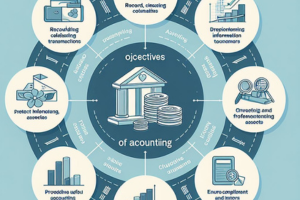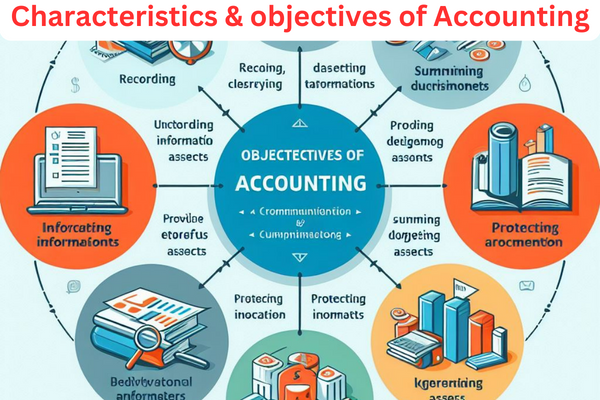Contents
What are the main characteristics & objectives of accounting?
Characteristics & objectives of Accounting are the attributes of the accounting information such as tend to enhance its understandability and usefulness & useful information to the interested group of users, both external and internal. Accounting, regularly taking into consideration the language of business, performs an important role in the financial landscape.
It’s no longer just about lowering the numbers; It is a systematic manner that enables people and organizations to keep track of their budgets, make knowledgeable choices, and obtain their monetary dreams. From giving monetary lucidity to working with powerful direction, how about we investigate how bookkeeping shapes how we deal with our assets and explore the mind-boggling universe of money?
Characteristics of Accounting
Qualitative characteristics of accounting are the attributes of accounting info that tend to strengthen its comprehensibility and utility.

To assess whether accounting info is named helpful, it should possess the characteristics of dependability, relevance, comprehensibility, and equivalence.
Main Characteristics of Accounting
1. Reliability
Reliability ability the purchasers should be capable of believing the knowledge. The reliability of accounting statistics is set by way of the diploma of correspondence between what the facts convey about the transactions or occasions that have occurred, measured, and displayed. A piece of dependable information should be free from error and bias and faithfully represent what it’s meant to represent. To make certain reliability, the facts disclosed should be credible, and verifiable by way of unbiased events using the identical approach of measuring and being neutral and faithful.
2. Relevance
To be relevant, facts have to be accessible in time, ought to help in prediction and feedback, and ought to affect the selections of customers with the aid of :(a) assisting them to shape predictions about the results of past, current, or future events; and/or (b) confirming or correcting their previous evaluations.
3. Understandability
Understandability capability decision-makers ought to interpret accounting information in an identical experience as it is organized and conveyed to them. The qualities that distinguish between the right and awful conversation during a message are integral to the understandability of the message. A message is said to be successfully communicated when it is interpreted by the receiver of the message in the equal experience that the sender has sent. Accountants should present the same facts in the most intelligible manner without sacrificing relevance and reliability.
4. Comparability
It is not ample that the economic data is applicable and dependable at a singular time, during a specific circumstance, or for a singular reporting entity. But it’s equally necessary that the purchasers of the regularly occurring motive economic reports can evaluate a variety of things of an entity over a definite time duration and with different entities. To be comparable, accounting reviews need to belong to a standard duration and use a frequent unit of size and structure of reporting.
5. Record-Keeping
At its core, accounting involves meticulous record-keeping. It’s like maintaining a detailed diary of every financial transaction. These transactions could include sales, purchases, payments, receipts, and more. Individuals and corporations may keep track of where their money is coming from and leaving by maintaining accurate records.
6. Historical Aspect
Accounting has a historical dimension. It captures financial events as they occur, creating a trail of financial history. This historical data provides insights into an entity’s financial health over time, aiding in the assessment of its performance and growth.
7. Monetary Measurement
One of the unique features of accounting is its focus on quantifying financial activities in monetary terms. This uniform measurement allows for easier comparison of different transactions and activities, making it simpler to analyze and interpret financial data.
8. Objective and Reliable
Accuracy is the backbone of accounting. The information recorded must be objective, verifiable, and reliable. This reliability is crucial for making sound financial decisions based on accurate data.
9. Consistency
Consistency ensures that accounting methods and principles remain uniform over time. This helps maintain a clear and transparent financial trail, even when different people are involved in the accounting process.
10. Relevance and Timeliness
Accounting information needs to be relevant and timely. It should be presented in a way that assists decision-making and provides insights into an entity’s financial position in the present and future.
11. Entity Perspective
Accounting treats the business or individual as a separate economic entity, distinct from its owners or stakeholders. This separation ensures that personal transactions don’t get mixed up with business transactions.
12. Going Concern Assumption
Accounting assumes that the entity will continue to operate in the foreseeable future. This assumption forms the basis for preparing financial statements, taking into account long-term obligations and commitments.
Objectives of Accounting
As a records system, the elemental goal of accounting is to grant useful information to the fascinated crew of users, each exterior and internal.

The necessary information, especially in the case of exterior users, is supplied in the shape of economic statements, viz., income and loss account, and balance sheet. Besides these, the administration is provided with additional information from time to time from the accounting documents of the business.
The objectives of Accounting
1. Maintenance of Records of Business Transactions
Accounting is used for the protection of a systematic document of all financial transactions in the books of accounts. Even the foremost notable govt or manager cannot precisely take into consideration the several quantities of various transactions like purchases, sales, receipts, payments, etc. that take location in business every day.
2. Calculation of Profit and Loss
The proprietors of the enterprise want to have a notion about the web effects of their business operations periodically, i.e. whether the commercial enterprise has earned profits or incurred losses. Thus, the other goal of accounting is to verify the profit earned or loss sustained by way of a billboard enterprise during an accounting period, which may be effortlessly exercised with the assistance of a file of incomes and expenses relating to the commercial enterprise by using getting ready an income or loss account for the period. Profit represents the extra income (income).
3. Depiction of Financial Position
Accounting additionally goals at ascertaining the monetary role of the business within the structure of its property and liabilities at the cease of every accounting period. A suited report of sources owned using the enterprise company (Assets)and claims towards such sources (Liabilities) allows the practice of a press release recognized as a stability sheet role statement.
4. Providing Accounting Information to its Users
The accounting statistics generated by using the accounting procedure are communicated within the structure of reports, statements, graphs, and charts to the users who want it in distinctive choice situations. As already stated, there are two primary person groups, viz. interior users, more often than not management, who need timely statistics on the worth of sales, profitability, etc. for planning, controlling, and decision-making, and exterior customers who have restricted authority, ability, and assets to acquire the imperative data and have to be counted on financial statements (Balance Sheet, Profit, and Loss account).
5. Financial Clarity
One of the primary objectives of accounting is to provide a clear and accurate picture of an entity’s financial health. This involves recording all financial transactions, categorizing them, and summarizing them in financial statements.
6. Facilitating Decision-Making
Accounting information empowers individuals and businesses to make informed decisions. It helps answer crucial questions such as whether to invest in a new project, expand operations, or optimize costs.
7. Assessing Performance
Through accounting, entities can assess their performance over time. Financial statements like the income statement and balance sheet provide insights into profitability, liquidity, and overall financial stability.
8. Measuring Accountability
Accountability is a cornerstone of accounting. It ensures that entities are answerable for their financial activities to various stakeholders, including investors, creditors, and regulatory bodies.
9. Compliance with Regulations
Accounting ensures compliance with legal and regulatory requirements. Accurate and transparent financial reporting is essential for fulfilling tax obligations and adhering to accounting standards.
10. Resource Allocation
Efficient resource allocation is critical for growth and sustainability. Accounting aids in allocating resources optimally by revealing areas of excess expenditure and opportunities for investment.
11. Evaluating Creditworthiness
Lenders and creditors rely on accounting information to evaluate an entity’s creditworthiness. A strong financial track record increases the likelihood of securing loans and favorable credit terms.
12. Valuation of Assets and Liabilities
Accounting provides a systematic approach to valuing assets and liabilities. This is crucial for determining the net worth of an entity and its ability to meet its obligations.
13. Performance Assessment
Entities often set financial goals and benchmarks. Accounting helps track progress towards these goals, highlighting areas that require attention and improvement.
14. Transparency and Stakeholder Confidence
Transparent financial reporting enhances stakeholder confidence. It allows investors, shareholders, and other interested parties to assess an entity’s financial integrity and make informed decisions.
Primarily, external users are involved in the following
- Investors and attainable information on the dangers and return on investment.
- Unions and worker groups information on the stability, profitability, and distribution of wealth inside the business; Lenders and monetary institutions on the creditworthiness of the organization and its capability to repay loans and pay interest.
- Suppliers and information on whether quantities owed will be repaid when due and on the endured existence of the business.
- Information on the persevered existence of the commercial enterprise and thus the likelihood of a persistent provider of products, components, and after-sales service.
- Government and different regulators-records on the allocation of resources and the compliance to regulations.
- Social duty groups, such as environmental groups-information on the influence on the surroundings and their protection.
- Competitors-information on the relative strengths and weaknesses of their competition and for comparative and benchmarking purposes. Whereas the above classes of users share in the wealth of the company.
- Competitors require statistics in general for strategic purposes.
Unique credit repair program with audio, video, and interactivity–not just another e-book. The world’s simplest and best credit improvement Read more
Youthpreneur – Day One or One Day
Accounting is a feature of managing the finances of any organization in the right place and correcting the financial condition. Which makes any organization more reliable in understanding. Accounting is aimed toward properly posing for business transactions, profit and loss, financial position, and accounting statistics of any organization. Accounting is more than just numbers; it’s a dynamic process that brings financial clarity and empowers decision-making. Its characteristics, such as record-keeping and historical perspective, lay the foundation for its objectives. By facilitating transparency, aiding in decision-making, and ensuring compliance, accounting serves as an indispensable tool for individuals and businesses striving for financial success. Whether you’re a small business owner or an individual managing personal finances, understanding the characteristics and objectives of accounting can be your compass in the intricate landscape of finance.


4 thoughts on “Characteristics & objectives of Accounting”